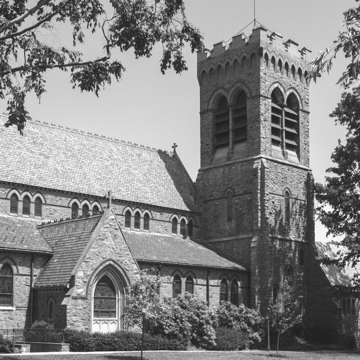As the flood tide of Ruskinian Gothic spread across industrial Pennsylvania, Philadelphia industrialists commissioned a parish church in this newly wealthy suburb. Foundry operator Charles Wheeler offered to help fund the church, if iron was used “and treated as such.” In the end, Burns's historical approach won out but he warmed the gray stone exterior walls with red and black brick and hints of Italian Gothic in the machicolations of the bell tower. These elements have more force than the flaccid limestone detail of the rose window of Evans, Warner and Bigger's replacement western facade. Their shift away from the original Ruskinian Gothic marks the ascendancy of the French Gothic that would characterize the twentieth-century Gothic Revival influenced by Henry Adams's homage to Mont St. Michel. Within, Burns followed the model of William Butterfield's London churches using structural brick in decorative patterns to frame arches and enliven the blank walls; his choice of a light tan brick for the field with red and black accents has worn well and remains in pristine condition. John Ruskin's call to honor religious belief through costly effect is much in evidence in Burns's
Other churches in the immediate vicinity include the immense Art Deco–influenced Gothic pile of the Bryn Mawr Presbyterian Church at Montgomery Avenue by Karcher and Smith, constructed in 1925–1927. Its glazed industrial tile interior recently covered by plaster recalled the industrial heritage of the region. To the southeast where Pennswood Street crosses Montgomery Avenue and the Amtrak tracks is the gray granite Gothic Revival Roman Catholic Church of Our Mother of Good Counsel, with its canted tower to the north and its similarly skewed entrance portico crowned by a pyramidal red tile roof. Designed by Edwin Forrest Durang in 1896, the interior is a tour de force of late-nineteenth-century structural sleight of hand. The ceiling reflects the usual side aisle and central nave interior, but the nave colonnade is missing. The decorative bosses from which hang the chandeliers are like the capitals of a nave arcade, but the ceiling is hung from trusses concealed beneath the plaster.






